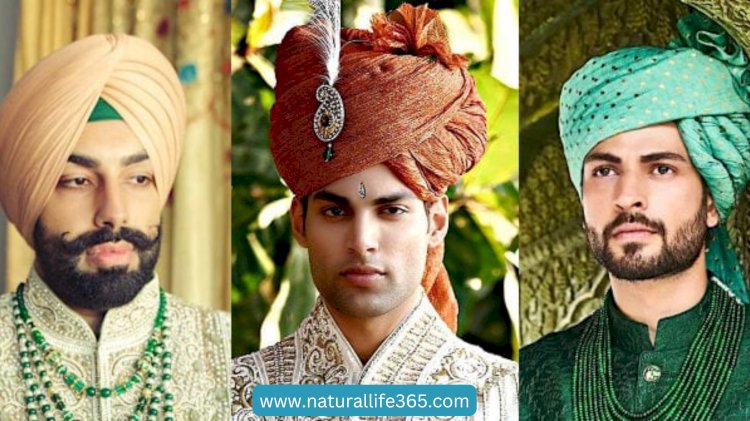Why Turbans Hold Special Meaning in Indian Tradition
Discover why turbans hold special meaning in Indian tradition. Learn about their cultural significance, symbolism, and the various traditions associated with them.

Turbans are more than just a piece of cloth wrapped around the head; they are a powerful symbol of cultural identity, spirituality, and social status in India. The tradition of wearing turbans, known by various names across different regions of the country, is deeply ingrained in the fabric of Indian society. From the vibrant, towering turbans of Rajasthan to the elegant, closely wrapped turbans of Punjab, each style and color carries its own unique significance, reflecting the wearer’s heritage, religion, and even profession.
This article delves into the history, cultural significance, and symbolism of turbans in Indian tradition, exploring how this age-old practice continues to play a vital role in the country’s diverse cultural landscape.
Historical Roots of Turbans in India
The tradition of wearing turbans in India dates back thousands of years, with evidence suggesting that the practice was prevalent as early as the Vedic period (1500–500 BCE). Ancient Indian texts, such as the Rigveda, mention the use of head coverings, which were likely precursors to the turbans worn today. Over time, the turban evolved into a symbol of nobility and honor, worn by kings, warriors, and spiritual leaders.
During the Mughal era (1526–1857), turbans became an essential part of courtly attire. The Mughals, who had a significant influence on Indian culture, popularized elaborate styles of turbans, often adorned with jewels and feathers. These turbans, known as pagris, became a status symbol among the nobility, with different styles indicating the wearer’s rank and region. The influence of the Mughal style can still be seen in some contemporary turban styles in North India.
Regional Variations and Styles
India’s diverse culture is reflected in the numerous regional variations of turbans, each with its own distinctive style and meaning. Some of the most notable regional turban styles include:
- Rajasthan: The turbans of Rajasthan, known as safa or pagri, are among the most colorful and elaborate in India. They are often made from bright, multi-colored fabrics and are worn in a towering style that can reach up to a meter in height. The style, color, and pattern of a Rajasthani turban can indicate the wearer’s caste, region, and even the occasion they are celebrating. For example, a saffron-colored turban symbolizes valor and heroism, while a white turban is typically worn during mourning.
- Punjab: In Punjab, the turban is an integral part of Sikh identity. The Sikh turban, known asdastar or pagri, is a symbol of faith, honor, and spirituality. Sikhs believe that wearing a turban is a way of respecting the divine creation of God, as it covers the hair, which is considered sacred. The Sikh turban is usually made from a plain, unadorned cloth and is tied in a specific manner that requires skill and practice. The turban is also a marker of the Sikh commitment to equality, as all Sikhs, regardless of social status, wear the turban as a sign of their shared faith.
- Maharashtra: The pheta is a traditional turban worn by men in Maharashtra, especially during weddings and religious ceremonies. It is usually bright orange or saffron, colors associated with Hinduism and the Maratha warriors. The style of the pheta can vary, with some being more tightly wrapped and others having a more relaxed, flowing appearance. The turban in Maharashtra is often seen as a symbol of pride and honor, especially among the Maratha community.
- Tamil Nadu: In Tamil Nadu, turbans are worn by certain communities as a symbol of authority and respect. The turai is a simple, white, or cream-colored turban that is often worn by village leaders or elders during important ceremonies. Although less elaborate than the turbans of North India, the turai holds a deep cultural significance in Tamil Nadu, symbolizing wisdom and leadership.
You can also read Why Garland (Varmala) Are Important in Indian Wedding Ceremonies
Religious Significance of Turbans
Turbans hold profound religious significance in India, particularly among Sikhs, Hindus, and Muslims. For many, the turban is not just a cultural artifact but a symbol of deep spiritual importance.
- Sikhism: The Sikh turban, or dastar, is perhaps the most well-known and significant turban in Indian culture. For Sikhs, the turban is a symbol of their faith and identity. The practice of wearing a turban was established by Guru Gobind Singh, the tenth Sikh Guru, who mandated that all baptized Sikhs must wear a turban as part of their religious duty. The turban serves as a reminder of the Sikh values of courage, self-respect, and humility. It is also a symbol of the Sikh commitment to social equality, as all Sikhs, regardless of their background, wear the turban as a sign of their unity and shared faith.
- Hinduism: In Hinduism, the turban is often associated with divinity and kingship. Hindu gods and goddesses are frequently depicted wearing turbans, symbolizing their divine authority and power. In many Hindu rituals, the turban is worn as a mark of respect and reverence, particularly during weddings and religious ceremonies. For example, during a Hindu wedding, the groom traditionally wears a turban to signify his role as the head of the household and to honor his ancestors.
- Islam: In Islam, the turban, known as imama, is considered a Sunnah (tradition) of the Prophet Muhammad. While not obligatory, wearing a turban is seen as a sign of respect for the Prophet and a symbol of piety. In India, many Muslim scholars and spiritual leaders wear turbans as a mark of their religious authority. The turban is also worn during special religious occasions, such as Friday prayers and Islamic festivals, to signify devotion and humility before God.
Symbolism of Turbans in Social and Political Contexts
Beyond their religious and cultural significance, turbans have also played an important role in social and political contexts in India. Throughout history, the turban has been used to convey messages of resistance, solidarity, and identity.
- Social Status: In many parts of India, the style, color, and material of a turban can indicate the wearer’s social status and profession. For example, in Rajasthan, the length and fabric of a turban can signify a person’s wealth and position in society. Similarly, in Punjab, the color of a turban can denote a person’s age and marital status, with older men often wearing darker colors and younger men wearing brighter, more vibrant shades.
- Political Identity: Turbans have also been used as a symbol of political identity and resistance. During the British colonial period, the turban became a symbol of defiance against colonial rule. Many Indian freedom fighters, including Mahatma Gandhi, adopted the turban as a way of asserting their cultural identity and rejecting Western norms. The turban was seen as a symbol of Indian self-respect and dignity, and wearing it was an act of resistance against British attempts to impose Western dress codes on Indians.
- Contemporary Significance: In contemporary India, the turban continues to hold symbolic importance, particularly in the context of social and political movements. For example, during the farmers’ protests in 2020–2021, many protesters wore turbans as a symbol of their cultural identity and resistance against perceived injustices. The turban served as a powerful reminder of the protesters’ connection to their land, heritage, and the long history of agrarian resistance in India.
The Art of Tying a Turban
Tying a turban is an art form in itself, requiring skill, precision, and practice. The process of tying a turban varies depending on the style and region, but it generally involves wrapping a long piece of cloth around the head in a specific pattern. The length of the cloth can vary from a few meters to over ten meters, depending on the style of the turban.
In Punjab, for example, tying a Sikh turban involves wrapping the cloth around the head in a way that creates a distinctive, pointed front. The process is often taught from a young age, with many Sikh men and boys learning the art of turban-tying from their fathers or grandfathers. The process is both a practical and spiritual act, as the turban is considered a sacred garment that should be treated with respect.
In Rajasthan, the process of tying a turban can be more elaborate, with different techniques used to create various styles and shapes. The safa is typically tied in a way that creates a large, rounded shape on the top of the head, with the ends of the cloth often left hanging down the back or over the shoulder. The process can take several hours and is often done with the help of family members or professional turban tiers, especially during special occasions such as weddings or festivals.
The Future of Turbans in Indian Tradition
As India continues to modernize and globalize, the tradition of wearing turbans faces new challenges and opportunities. On one hand, the influence of Western fashion and changing social norms has led to a decline in the daily use of turbans, particularly among younger generations. Many young men in urban areas prefer Western-style clothing and hairstyles, viewing the turban as outdated or cumbersome.
On the other hand, there has been a resurgence of interest in traditional attire and cultural identity, particularly in the context of global movements for indigenous rights and cultural preservation. For many Indians, the turban remains a powerful symbol of their heritage and identity, and efforts are being made to preserve and promote the tradition. Fashion designers, cultural organizations, and religious institutions are all playing a role in keeping the tradition of turbans alive, whether by incorporating traditional styles into modern fashion or by educating younger generations about the cultural significance of the turban.
You can also read Understanding the Indian Caste System
Fascinated by the deep cultural significance of turbans in India? Dive deeper into our collection of articles on Indian traditions, spirituality, and regional customs. Don't miss out on the new posts, or share your thoughts in the comments below! Let's continue the conversation on India's vibrant cultural tapestry.
If you value these free online resources provided by Natural Life 365, please consider supporting my website by sharing the blogs ![]()






































